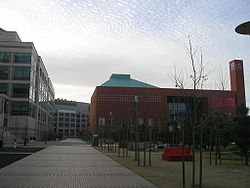Mission Bay, San Francisco
| Mission Bay | |
|---|---|
| Neighborhood | |

Construction of the new UCSF campus at Mission Bay began in 1999.
|
|
| Location within Central San Francisco | |
| Coordinates: 37°46′13″N 122°23′27″W / 37.77018°N 122.39091°WCoordinates: 37°46′13″N 122°23′27″W / 37.77018°N 122.39091°W | |
| Country |
|
| State |
|
| City-county | San Francisco |
| Government | |
| • Supervisor | Jane Kim |
| • State Assembly | David Chiu (D) |
| • State Senator | Scott Wiener (D) |
| • U. S. Rep. | Nancy Pelosi (D) |
| Area | |
| • Total | 0.842 sq mi (2.18 km2) |
| Population | |
| • Total | 5,390 |
| • Density | 6,400/sq mi (2,500/km2) |
| Time zone | Pacific (UTC-8) |
| • Summer (DST) | PDT (UTC-7) |
| ZIP codes | 94103, 94107 |
| Area codes | 415/628 |
Mission Bay is a 303-acre (123 ha) neighborhood in San Francisco, California. It is the home of the Chase Center (San Francisco) that will open in 2019. It is located on the east side of the city, outside Downtown San Francisco. Mission Bay is a sub-neighborhood of SoMa and borders China Basin to the north and Dogpatch to the south.
Mission Bay is roughly bounded by Townsend Street on the north, Third Street and San Francisco Bay on the east, Mariposa Street on the south, and 7th Street and Interstate 280 on the west.
Before urbanization, Mission Bay was nestled inside of a +500 acre salt marsh and lagoon, and was occupied by year-round tidal waters. This area was a natural habitat and refuge for large water fowl populations that included ducks, geese, herons, egrets, ospreys and gulls. The Native American tribes who resided in this area were the Costanoan people who spoke eight different languages which delineated between the various tribelets. The tribe most prevalent in the Bay area was the Patwin people who resided in the area for over 5,000 years.
Beginning in the mid-1800s, in attempts to make this area suitable for building, Mission Bay was used as a convenient place to deposit refuse from building projects and debris from the 1906 earthquake. As the marsh quickly stabilized with the weight of the infill, the area quickly became an industrial district. By 1850 the area was used for shipbuilding and repair, butchery and meat production, and oyster and clam fishing. With the addition of the railroad, Mission Bay became the home to shipyards, canneries, a sugar refinery and various warehouses.
...
Wikipedia

